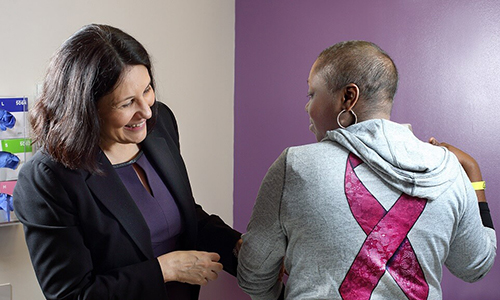Invasive Ductal Carcinoma (IDC)
Featured Expert:
Invasive ductal carcinoma, also known as infiltrating ductal carcinoma or IDC, is the most common form of breast cancer, accounting for 80% of all breast cancer diagnoses.
Pamela Wright, M.D., medical director of the Breast Center at Johns Hopkins’ Suburban Hospital, tells you what you should know about IDC, its diagnosis and advancements in treatment.
What You Need to Know
- The risk of getting invasive ductal breast cancer increases with age: According to the American Cancer Society, about two-thirds of women diagnosed with IDC are age 55 or older.
- IDC can affect men.
- Without prompt treatment, invasive ductal carcinoma can spread to lymph nodes or blood vessels and metastasize (spread) throughout the body.
- Identifying characteristics of the tumor, such as whether or not the cells are sensitive to certain hormones, can help your doctor choose the best treatment.
What is invasive ductal carcinoma?
Breast ducts are the passageways where milk from the milk glands (lobules) flows to the nipple.
Invasive ductal carcinoma is cancer (carcinoma) that happens when abnormal cells growing in the lining of the milk ducts change and invade breast tissue beyond the walls of the duct.
Once that happens, the cancer cells can spread. They can break into the lymph nodes or bloodstream, where they can travel to other organs and areas in the body, resulting in metastatic breast cancer.
What are the symptoms of invasive ductal carcinoma?
“Like other breast cancers, IDC may present as a lump that you or your doctor can feel on a breast exam. But in many cases, at first, there may be no symptoms,” Wright says.
“That is why it is important to have screening mammograms to detect breast cancers such as invasive ductal carcinoma. A mammogram may detect a lump that is too small for you to feel, or suspicious calcifications in the breast, either of which will lead to further testing.”
According to Wright, the following are possible signs of invasive ductal carcinoma and other breast cancers. If you notice any of these, you should contact your doctor right away for further evaluation:
- Lump in the breast
- Thickening or redness of the skin of the breast
- Swelling or change in the shape of the breast
- Localized persistent breast pain
- Dimpling or retraction of the skin of the breast or the nipple
- Nipple discharge, other than breast milk
- Scaly or flaky skin on the nipple or an ulceration (sore) on the skin of the breast or nipple. These can be signs of Paget’s disease, a different kind of breast cancer that can occur along with IDC.
- Lumps in the underarm area
- Changes in the appearance of the nipple or breast that are different from your normal monthly changes
How is invasive ductal carcinoma diagnosed?
Several tests can help your doctor identify and diagnose IDC, including:
Physical exam. Manual examination of your breasts by your doctor can detect lumps and other changes. If your doctor feels a lump or thickening, he or she may recommend further tests to rule out IDC.
Digital mammography is an improved method for breast imaging that is performed much like a regular mammogram. However, it is better than conventional mammography in detecting cancer in younger patients and in those with dense breast tissue. Electronic images can be enhanced with computer-aided detection systems to spot masses, calcifications and abnormalities associated with cancer.
Breast ultrasound uses sound waves to examine the breast tissue and gauge blood flow. It is safe for examining pregnant patients, and does not use radiation.
Breast magnetic resonance imaging (MRI) uses a large magnet, radio waves and a computer that can detect small breast lesions, and may be especially useful in examining patients with a high risk of breast cancer, such as those with BRCA1, BRCA2 or other gene mutations associated with cancer.
Schedule Your Mammogram

Biopsy. A breast biopsy involves taking a sample of breast tissue from a suspicious area and sending it to a laboratory for microscopic examination by a pathologist, a doctor who specializes in identifying signs of disease. A biopsy can confirm or rule out the presence of cancer and, if cancer is present, reveal its characteristics.
Staging workup. When cancer is detected, the next step is staging. “Staging determines how far the cancer cells have spread,” Wright says. “Staging is based on the size of the tumor and whether or not it has spread to the lymph nodes or entered the bloodstream and spread anywhere else in body.”
Invasive Ductal Carcinoma Treatment
“Treatment is based on the size and location of the cancer cells, the features or characteristics of those cells, and the staging,” Wright says. Depending on these factors, your doctor will recommend a plan that includes one or more of the following treatments.
Surgery for Invasive Ductal Carcinoma
Breast cancer treatment has evolved to offer patients more options. In addition to removing breast cancer, new aesthetic surgical approaches can enhance well-being and lessen the emotional impact of losing all or part of a breast to cancer. Comprehensive breast centers with coordinated teams of oncologic and plastic surgery practitioners can offer a wider array of options.
Surgery for IDC may include one of these procedures:
- Lumpectomy is removal of part of the breast. It is also known as breast-conserving surgery. Lumpectomy may be followed by radiation treatments to treat any remaining cancer cells.
- Mastectomy is removal of the breast. Mastectomy is a treatment for patients with multiple, very aggressive, or large invasive ductal tumors. It can be followed by breast reconstruction.
Nonsurgical Invasive Ductal Carcinoma Treatment
Radiation. Radiation therapy might be part of your treatment plan if you are undergoing a lumpectomy. Studies show that lumpectomy followed by radiation can be as effective in treating IDC as mastectomy. “We don’t usually treat patients with radiation after a mastectomy unless there’s some cancer in the lymph nodes,” Wright says.
Chemotherapy. Deciding on whether to treat invasive ductal breast cancer with chemotherapy, or “chemo,” depends on features of the tumor cells themselves — their genes and proteins. The more the doctor can learn about the characteristics of the cancer cells, the easier it is to determine what type of chemotherapy (if any) is likely to be effective.
Hormone therapy. Breast cancers with positive hormone receptors can be treated with estrogen or progesterone. These medications come in pill form, and may be prescribed for several years.
Biologic (targeted) therapy. This approach uses antibodies or small molecule drugs to activate your body’s immune system to fight the invasive ductal cancer cells.
Deciding on Invasive Ductal Carcinoma Treatment
Treatment for ductal breast cancer is not one size fits all. Your doctor will consider several factors in putting together an individualized treatment plan for you, including how advanced the cancer is and the characteristics of the tumor or tumors.
Wright says the biopsy can reveal how the tumor is likely to respond to various therapies. For example, analysis may reveal the presence of certain proteins on the cells’ surface (such as human epidermal growth factor 2, or HER2) or hormone receptors for estrogen or progesterone. These characteristics can indicate tumors that can be treated with hormone therapy.
Checking for Ductal Breast Cancer in Lymph Nodes
“The goal of invasive ductal carcinoma treatment is to get the cancer out of the breast. But we also may need to remove lymph nodes if the cancer has spread there,” Wright explains.
Your lymph nodes are part of your immune system. Lymph fluid from the breast drains into the axillary (under arm) lymph nodes. The number and location of axillary lymph nodes may be different from person to person.
A sentinel lymph node biopsy is a test that can help your doctor determine if removing lymph nodes may be part of your cancer surgery.
The sentinel lymph node is where cancer from invasive ductal carcinoma is likely to show up first. Your doctor can identify the sentinel lymph node by injecting dye into the breast and seeing which node takes up the dye first: This is the sentinel. A sample of tissue from this node (biopsy) can reveal if cancer has spread there.
“If there’s no cancer in the sentinel node, the other nodes are OK and don’t need to be removed,” says Wright. “If there’s a small amount of cancer present, we’ll leave nodes in place and treat the area with radiation or use chemotherapy.
“If we see a lot of cancer in the lymph nodes or if four or more lymph nodes are affected, we perform an axillary lymph node dissection: surgery to remove the nodes.”
Did you know? Men can get breast cancer, too

About 1 in 100 breast cancers occurs in men. Though men do not have enough lobular tissue to produce milk, they do have milk ducts, and cancer can arise there.
Rare types of invasive ductal carcinoma
Medullary ductal carcinoma accounts for only 3%–5% of breast cancers. It may appear on a mammogram, and it does not always feel like a lump; rather, it can feel like an abnormally spongy area in the breast tissue.
Mucinous ductal carcinoma is also called colloid breast cancer. It occurs when cancer cells within the milk duct of the breast produce mucous, which also contains breast cancer cells. The cells and mucous combine to form a tumor. Pure mucinous ductal carcinoma tends to grow slowly, and has a better prognosis than some other types of IDCs.
Papillary carcinoma forms finger-like projections (papules) that can be seen under a microscope. Many papillary tumors are benign, but even those that become cancerous are usually very treatable with a good prognosis. Papillary carcinoma most commonly occurs in people older than 60.
Tubular ductal carcinoma is a rare diagnosis of IDC, comprising only 2% of breast cancer diagnoses. The name comes from how the cancer looks under the microscope — like hundreds of tiny tubes. Tubular breast cancer has an excellent prognosis.
What is the prognosis for invasive ductal carcinoma?
Your doctor will discuss what you can expect based on the characteristics of the invasive ductal carcinoma and the effectiveness of your treatment.
Specialty centers such as Johns Hopkins Medicine’s Breast Health Services can offer integrated teams of breast cancer specialists who have skill and experience in surgery, breast reconstruction, chemotherapy, biologic targeted therapy, radiation therapy and other hormonal therapies.
“Medical science is making great strides forward in treating breast cancer, allowing our surgeries to be less invasive and improving surgical outcomes and overall quality of life,” Wright says.
Breast Health Services

Johns Hopkins breast health services include preventive and noncancerous surgical treatment, risk assessment, diagnostic screenings and treatment for breast cancer.







